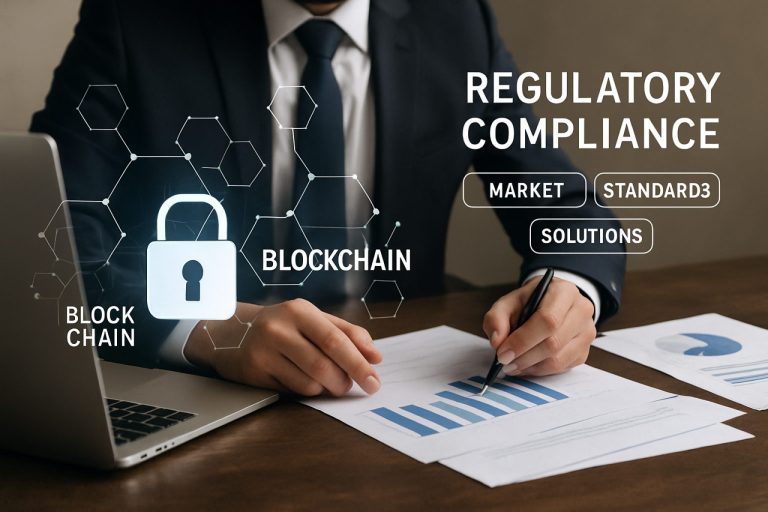
Risk Scoring Algorithms for Cryptoasset KYC in 2025: Market Dynamics, AI Integration, and Regulatory Shifts. Explore Growth Drivers, Competitive Analysis, and Future Opportunities in Digital Asset Compliance.
- Executive Summary and Market Overview
- Key Technology Trends in Cryptoasset KYC Risk Scoring
- Competitive Landscape: Leading Vendors and Emerging Players
- Market Growth Forecasts 2025–2030: CAGR, Adoption Rates, and Revenue Projections
- Regional Analysis: North America, Europe, Asia-Pacific, and Emerging Markets
- Future Outlook: Evolving Regulatory Frameworks and AI Advancements
- Challenges and Opportunities: Data Privacy, Scalability, and Innovation
- Sources & References
Executive Summary and Market Overview
The rapid expansion of the cryptoasset sector has intensified the need for robust Know Your Customer (KYC) protocols, with risk scoring algorithms emerging as a cornerstone technology in 2025. These algorithms leverage advanced analytics, machine learning, and blockchain forensics to assess the risk profile of individuals and entities engaging with digital assets. The global market for risk scoring solutions tailored to cryptoasset KYC is projected to surpass $1.2 billion by 2025, reflecting a compound annual growth rate (CAGR) of over 20% since 2021, driven by regulatory pressure and the proliferation of illicit activities in decentralized finance (Statista).
Risk scoring algorithms for cryptoasset KYC analyze a multitude of data points, including wallet transaction histories, behavioral patterns, and cross-chain activity, to generate dynamic risk profiles. These systems are increasingly integrated with real-time blockchain analytics and external data sources, enabling financial institutions, exchanges, and fintechs to automate compliance and mitigate exposure to money laundering, terrorist financing, and fraud. The adoption of these algorithms is further accelerated by evolving global regulatory frameworks, such as the Financial Action Task Force (FATF) Travel Rule and the European Union’s Markets in Crypto-Assets (MiCA) regulation, which mandate enhanced due diligence and continuous monitoring (Financial Action Task Force; European Parliament).
- Key Market Drivers: Heightened regulatory scrutiny, increasing sophistication of crypto-related crime, and the need for scalable, automated compliance solutions.
- Leading Vendors: Major players include Chainalysis, Elliptic, and TRM Labs, all of which have expanded their risk scoring capabilities to cover a broader range of cryptoassets and compliance scenarios.
- Adoption Trends: Financial institutions and virtual asset service providers (VASPs) are increasingly integrating risk scoring algorithms into onboarding, transaction monitoring, and ongoing customer due diligence workflows.
In summary, the market for risk scoring algorithms in cryptoasset KYC is experiencing robust growth in 2025, underpinned by regulatory mandates and the escalating complexity of digital asset ecosystems. The sector is expected to continue evolving rapidly, with innovation focused on improving accuracy, scalability, and interoperability across jurisdictions and blockchain networks.
Key Technology Trends in Cryptoasset KYC Risk Scoring
Risk scoring algorithms are at the core of Know Your Customer (KYC) processes for cryptoassets, enabling institutions to assess the likelihood that a customer or transaction is associated with illicit activity. In 2025, these algorithms are evolving rapidly, driven by advances in artificial intelligence (AI), machine learning (ML), and blockchain analytics. The latest generation of risk scoring models integrates multiple data sources, including on-chain transaction histories, off-chain identity verification, behavioral analytics, and external watchlists, to generate dynamic and granular risk profiles.
One of the most significant trends is the adoption of AI-powered behavioral analytics. These systems analyze transaction patterns, wallet interactions, and network relationships to detect anomalies indicative of money laundering, fraud, or sanctions evasion. For example, solutions from Chainalysis and Elliptic leverage graph analytics and ML to identify suspicious clusters and flag high-risk wallets in real time. This approach moves beyond static rule-based systems, allowing for adaptive risk scoring that evolves with emerging threats.
Another key development is the integration of decentralized identity (DID) frameworks and verifiable credentials into risk scoring. By linking on-chain activity with verified off-chain identities, platforms can assign risk scores that reflect both the provenance of funds and the legitimacy of the user. Companies like Solidatus are pioneering data lineage solutions that help trace asset flows across multiple blockchains, further enhancing the accuracy of risk assessments.
Regulatory technology (RegTech) providers are also embedding real-time sanctions screening and adverse media monitoring into their risk scoring engines. This enables continuous assessment of customer risk as new information becomes available, rather than relying solely on periodic reviews. For instance, TRM Labs offers automated risk scoring that updates as wallets interact with new counterparties or as regulatory lists are updated.
- AI and ML are enabling more nuanced, context-aware risk scoring models.
- Integration of on-chain and off-chain data sources is improving risk visibility.
- Real-time monitoring and adaptive scoring are becoming industry standards.
- Decentralized identity and data lineage tools are enhancing transparency and traceability.
As regulatory expectations intensify and illicit actors become more sophisticated, the evolution of risk scoring algorithms will remain central to effective cryptoasset KYC in 2025 and beyond.
Competitive Landscape: Leading Vendors and Emerging Players
The competitive landscape for risk scoring algorithms in cryptoasset Know Your Customer (KYC) processes is rapidly evolving as regulatory scrutiny intensifies and the volume of digital asset transactions grows. In 2025, the market is characterized by a mix of established compliance technology vendors and innovative startups, each leveraging advanced analytics, machine learning, and blockchain intelligence to enhance risk assessment capabilities.
Leading vendors such as Chainalysis, Elliptic, and TRM Labs dominate the sector with comprehensive risk scoring solutions that integrate on-chain analytics, behavioral profiling, and real-time transaction monitoring. These platforms offer robust APIs and dashboards that allow financial institutions and crypto exchanges to automate KYC checks, flag suspicious activity, and comply with evolving Anti-Money Laundering (AML) regulations. Their algorithms typically aggregate data from multiple blockchains, dark web sources, and sanction lists to generate dynamic risk scores for wallets, transactions, and counterparties.
Emerging players are differentiating themselves through specialized approaches. For example, Scorechain and ComplyAdvantage are focusing on multi-asset coverage and customizable risk models tailored to specific regulatory jurisdictions. Startups like Merkle Science and Coinfirm are leveraging artificial intelligence to detect novel typologies of illicit activity, such as DeFi exploits and cross-chain laundering, which are increasingly relevant in 2025.
- Market Consolidation: The sector is witnessing strategic partnerships and acquisitions, as larger vendors seek to expand their data coverage and technical capabilities. For instance, Chainalysis has acquired smaller analytics firms to enhance its risk scoring engine and global reach.
- Regulatory Alignment: Vendors are racing to align their algorithms with new standards from bodies like the Financial Action Task Force (FATF) and regional regulators, driving innovation in explainable AI and transparent scoring methodologies.
- Open-Source and Consortium Models: Some emerging players are advocating for open-source risk scoring frameworks and industry consortia to improve transparency and interoperability across platforms.
As the market matures, differentiation will increasingly hinge on the granularity of risk insights, adaptability to new cryptoasset types, and the ability to provide actionable intelligence in real time. The competitive landscape in 2025 is thus defined by both technological innovation and the race to meet global compliance demands.
Market Growth Forecasts 2025–2030: CAGR, Adoption Rates, and Revenue Projections
The market for risk scoring algorithms tailored to cryptoasset Know Your Customer (KYC) processes is poised for robust expansion between 2025 and 2030, driven by escalating regulatory scrutiny, institutional adoption, and the proliferation of digital asset platforms. According to projections from MarketsandMarkets, the global market for crypto compliance solutions—including risk scoring algorithms—is expected to register a compound annual growth rate (CAGR) of approximately 18–22% during this period. This growth is underpinned by the increasing integration of advanced analytics and artificial intelligence into KYC workflows, enabling more granular and dynamic risk assessments for both retail and institutional clients.
Revenue from risk scoring algorithm solutions is forecasted to surpass $1.2 billion by 2030, up from an estimated $420 million in 2025, as reported by Grand View Research. This surge is attributed to the rapid onboarding of new users by crypto exchanges, decentralized finance (DeFi) platforms, and digital banks, all of which are under mounting pressure to comply with evolving anti-money laundering (AML) and counter-terrorism financing (CTF) regulations. The adoption rate of risk scoring algorithms among top-tier crypto exchanges is projected to exceed 75% by 2027, with mid-tier and emerging platforms following suit as regulatory frameworks mature globally.
- North America and Europe are expected to lead in adoption, driven by stringent regulatory mandates from bodies such as the Financial Crimes Enforcement Network (FinCEN) and the European Securities and Markets Authority (ESMA).
- Asia-Pacific is anticipated to experience the fastest CAGR, fueled by the rapid expansion of digital asset markets in countries like Singapore, Japan, and South Korea, alongside proactive regulatory initiatives.
- Integration with blockchain analytics and real-time transaction monitoring is expected to become standard, further boosting the demand for sophisticated risk scoring models.
Key industry players such as Chainalysis, Elliptic, and TRM Labs are investing heavily in R&D to enhance the predictive accuracy and scalability of their risk scoring engines. As regulatory expectations evolve and the cryptoasset ecosystem matures, the market for risk scoring algorithms in KYC is set to become a cornerstone of digital asset compliance infrastructure through 2030.
Regional Analysis: North America, Europe, Asia-Pacific, and Emerging Markets
The adoption and sophistication of risk scoring algorithms for cryptoasset Know Your Customer (KYC) processes vary significantly across North America, Europe, Asia-Pacific, and emerging markets, reflecting regional regulatory frameworks, market maturity, and technological infrastructure.
- North America: The United States and Canada lead in the deployment of advanced risk scoring algorithms, driven by stringent regulatory requirements from agencies such as the Financial Crimes Enforcement Network (FinCEN) and the Office of the Superintendent of Financial Institutions (OSFI). U.S.-based crypto exchanges and service providers invest heavily in AI-powered KYC solutions that integrate behavioral analytics, transaction monitoring, and external data sources to generate dynamic risk scores. The region’s mature fintech ecosystem and frequent enforcement actions have accelerated the adoption of real-time, adaptive risk scoring models.
- Europe: The European Union’s implementation of the Fifth and Sixth Anti-Money Laundering Directives (AMLD5/6) has standardized KYC requirements across member states, prompting widespread use of risk scoring algorithms. European firms emphasize privacy-preserving technologies and compliance with the General Data Protection Regulation (GDPR). Vendors such as Onfido and Trulioo have expanded their offerings to include explainable AI and cross-border risk assessment, reflecting the region’s focus on transparency and interoperability.
- Asia-Pacific: The region is characterized by rapid crypto adoption and regulatory diversity. Jurisdictions like Singapore and Japan have established clear KYC guidelines, fostering the use of risk scoring algorithms that leverage local identity databases and biometric verification, as seen with providers like Singtel and SBI Holdings. However, in less regulated markets, risk scoring remains inconsistent, with some exchanges relying on basic rule-based systems rather than advanced analytics.
- Emerging Markets: In Latin America, Africa, and parts of Southeast Asia, the adoption of risk scoring algorithms is nascent but growing. Limited regulatory clarity and infrastructure challenges hinder widespread implementation. Nonetheless, local fintechs and global players are piloting lightweight, mobile-first KYC solutions that incorporate simplified risk scoring, aiming to balance compliance with financial inclusion, as highlighted by Mercado Pago and Flutterwave.
Overall, while North America and Europe set the pace in algorithmic sophistication and regulatory alignment, Asia-Pacific and emerging markets are rapidly evolving, with innovation often shaped by local compliance needs and digital infrastructure.
Future Outlook: Evolving Regulatory Frameworks and AI Advancements
The future outlook for risk scoring algorithms in cryptoasset Know Your Customer (KYC) processes is shaped by two converging forces: rapidly evolving regulatory frameworks and significant advancements in artificial intelligence (AI). By 2025, global regulators are expected to intensify their scrutiny of cryptoasset service providers, demanding more robust, transparent, and explainable risk assessment mechanisms. The Financial Action Task Force (FATF) continues to update its guidance, pushing for stricter compliance with anti-money laundering (AML) and counter-terrorism financing (CTF) standards, including the implementation of risk-based approaches for virtual asset service providers (VASPs).
In response, risk scoring algorithms are anticipated to become more sophisticated, leveraging advanced AI techniques such as deep learning, natural language processing, and graph analytics. These technologies enable the analysis of vast, complex datasets—including on-chain transaction histories, off-chain behavioral signals, and cross-jurisdictional identity data—to generate dynamic, real-time risk profiles. Companies like Chainalysis and Elliptic are already integrating AI-driven analytics to enhance the granularity and accuracy of their risk scoring models, and this trend is expected to accelerate as regulatory expectations rise.
A key regulatory trend is the demand for algorithmic transparency and explainability. The European Union’s Markets in Crypto-Assets Regulation (MiCA) and the proposed EU AI Act both emphasize the need for clear documentation of how risk scores are generated, as well as mechanisms for human oversight and auditability. This is likely to drive the adoption of explainable AI (XAI) frameworks within KYC risk scoring, ensuring that compliance teams can justify decisions to regulators and customers alike.
Looking ahead to 2025, the convergence of regulatory pressure and AI innovation is expected to result in risk scoring algorithms that are not only more accurate and adaptive but also more transparent and auditable. This will enable cryptoasset firms to better detect and mitigate financial crime risks while maintaining compliance with increasingly stringent global standards. As a result, the competitive landscape will favor solution providers that can deliver both cutting-edge AI capabilities and robust regulatory alignment, positioning them as trusted partners in the evolving digital asset ecosystem.
Challenges and Opportunities: Data Privacy, Scalability, and Innovation
Risk scoring algorithms are at the heart of Know Your Customer (KYC) processes for cryptoassets, enabling compliance teams to assess the likelihood of illicit activity and ensure regulatory adherence. As the cryptoasset market matures in 2025, these algorithms face a complex landscape of challenges and opportunities, particularly in the areas of data privacy, scalability, and innovation.
Data Privacy: The implementation of risk scoring algorithms in cryptoasset KYC must navigate a tightening global regulatory environment. The European Union’s Markets in Crypto-Assets Regulation (MiCA) and the revised Anti-Money Laundering Directive (AMLD6) impose strict requirements on data handling and user privacy. Balancing effective risk assessment with compliance to privacy frameworks such as GDPR is a significant challenge. Companies like Chainalysis and Elliptic are investing in privacy-preserving analytics, leveraging zero-knowledge proofs and federated learning to minimize exposure of sensitive user data while maintaining robust risk detection capabilities.
Scalability: The exponential growth in cryptoasset transactions, driven by both retail and institutional adoption, places immense pressure on the scalability of risk scoring systems. Traditional rule-based models struggle to keep pace with the volume and complexity of blockchain data. In response, vendors are deploying machine learning and AI-driven solutions that can process vast datasets in real time. TRM Labs and CipherTrace have introduced cloud-native platforms capable of analyzing millions of transactions per second, enabling exchanges and financial institutions to scale their KYC operations without sacrificing accuracy or speed.
- Innovation: The evolving threat landscape and regulatory expectations are driving continuous innovation in risk scoring methodologies. Advanced behavioral analytics, network graph analysis, and cross-chain monitoring are being integrated to detect sophisticated money laundering typologies and sanction evasion. The emergence of decentralized finance (DeFi) and privacy coins presents new vectors for illicit activity, prompting solution providers to develop adaptive algorithms that can identify risks in previously opaque environments. Partnerships between analytics firms and regulators, such as those seen with Chainalysis and the Financial Crimes Enforcement Network (FinCEN), are fostering the development of industry standards and best practices.
In summary, while risk scoring algorithms for cryptoasset KYC in 2025 must overcome significant hurdles in data privacy and scalability, the sector is also witnessing rapid innovation. The convergence of regulatory pressure, technological advancement, and market demand is shaping a new era of compliance solutions that are more secure, efficient, and adaptable than ever before.
Sources & References
- Statista
- European Parliament
- Chainalysis
- Elliptic
- TRM Labs
- Solidatus
- Scorechain
- Merkle Science
- MarketsandMarkets
- Grand View Research
- Financial Crimes Enforcement Network (FinCEN)
- European Securities and Markets Authority (ESMA)
- Office of the Superintendent of Financial Institutions (OSFI)
- Fifth and Sixth Anti-Money Laundering Directives (AMLD5/6)
- General Data Protection Regulation (GDPR)
- Singtel
- Mercado Pago



